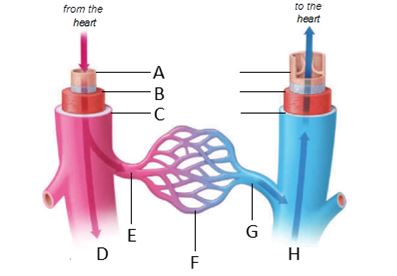Identify the labeled structures of the circulatory system in the figure below.  a. artery
a. artery
b. endothelium
c. capillary
d. arteriole
e. venule
f. vein
g. smooth muscle
h. connective tissue
-structure labeled "F"
Definitions:
Osmosis
A process by which molecules of a solvent tend to pass through a semipermeable membrane from a less concentrated solution into a more concentrated one.
Endometrial Tissue
The inner lining of the uterus, known as the mucous membrane, which becomes thicker throughout the menstrual cycle and is expelled during menstruation if pregnancy does not take place.
Nerve Tissue
A specialized tissue found in the nervous system, consisting of neurons and glial cells, that processes and transmits information through electrical and chemical signals.
Epithelial Tissue
The layer of cells covering the body surfaces, lining the body cavities, and forming the major part of glands, serving protective, secretion, and absorption functions.
Q2: produces melatonin<br>A)posterior pituitary<br>B)adrenal cortex<br>C)pancreas<br>D)thyroid<br>E)pineal<br>F)anterior pituitary<br>G)adrenal medulla<br>H)parathyroid
Q5: The _ is a bone of the
Q49: Innate immunity begins when _.<br>A) triggered by
Q58: A plant pathologist, a scientist who studies
Q60: An energy pyramid is _.<br>A) a demonstration
Q63: large amounts of bony tissue found at
Q64: In the accompanying figure, the structure labeled
Q67: adaptive immunity involving B cells<br>A)innate immunity<br>B)antibody-mediated immunity<br>C)adaptive
Q86: Climate is the _.<br>A) average weather condition
Q90: The enzyme lipoprotein lipase _.<br>A) decreases in